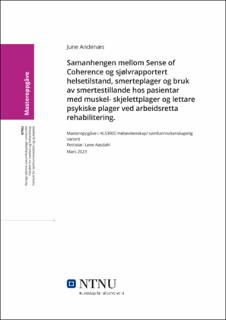| dc.contributor.advisor | Aasdahl, Lene | |
| dc.contributor.author | Andenæs, June | |
| dc.date.accessioned | 2023-06-13T17:19:14Z | |
| dc.date.available | 2023-06-13T17:19:14Z | |
| dc.date.issued | 2023 | |
| dc.identifier | no.ntnu:inspera:141416530:141304525 | |
| dc.identifier.uri | https://hdl.handle.net/11250/3071202 | |
| dc.description.abstract | Samandrag
Bakgrunn: Muskel- og skjelettlidingar er sterkt forbunde med smerter og har ein betydeleg overlapp med angst og depresjon når det kjem til sjukefråvær, uførheit og forverring av smerteoppleving. Sense of Coherence (SOC) er ein avgjerande faktor for kor godt ein person handterer stress og held seg frisk. SOC kan difor vere ein viktig meistringsstrategi hos personar med smerter og ein prediktor på helse, smerter og bruk av smertestillande. Det er behov for meir forsking kring tema grunna sprikande resultat i tidlegare studiar og lite forsking.
Hensikt: Undersøkje samanhengen mellom SOC og sjølvrapportert helsetilstand, smerteplager og bruk av smertestillande hos pasientar med muskel-skjelettplager og lettare psykiske plager i arbeidsretta rehabilitering .
Metode: Ein tverrsnittstudie. Utvalet (N = 2144) består av personar i yrkesaktiv alder med diagnosar innan muskel- og skjelettplager og/ eller lette psykiske lidingar som deltar i arbeidsretta rehabilitering ved Friskgården. Fysisk form, daglege aktivitetar og samla helsetilstand blei målt med spørjeskjema COOP/WONCA. Utholdenheit, og smerteplager målt med VAS-skala 0-10, SOC blei målt med spørjeskjema SOC-13 og bruk av smertestillande målt ved to kategoriar. Samanhengen mellom SOC og henholdsvis utholdenheit, fysisk form, daglege aktivitetar, samla helsetilstand og smerteplager blei gjennomført med lineær regresjonsanalyse, både ujustert og justert for alder, kjønn og utdanning. Samanhengen mellom SOC og smertestillande vart gjennomført ved logistisk regresjonsanalyse ujustert og justert for alder, kjønn og utdanning.
Resultat: 2144 deltakarar ved arbeidsretta rehabilitering vart inkludert i studien, 2/3 var kvinner. Gjennomsnittleg SOC hos utvalet var 54.8 (SD=6.9). Justert for alder, kjønn og utdanning var det funne statistisk signifikante samanhengar mellom SOC og utholdenheit (B=0.07, 95%CI= 0.05-0.08), daglege aktivitetar (B= 0.04, 95%CI=0.03-0.04) og samla helsetilstand (B=0.03, 95%CI= 0.03-0.04). Fysisk form (B=0.00, 95%CI= -0.01-0.01) viste ingen signifikant samanheng med SOC. Det var heller ikkje samanheng mellom SOC og smerteplager (B=0.00, 95%CI=-0.02-0.02) eller smertestillande (Odds Ratio=1.00, 95% CI = 0.99-1.02)
Konklusjon: Studien fann statistisk signifikante, men kun svake positive samanhengar mellom SOC og utholdenheit, daglege aktivitetar og samla helsetilstand. Dess sterkare SOC dess betre utholdenheit, mindre vanskar med daglege aktivitetar og betre samla helsetilstand. Statistisk signifikante samanhengar, men neppe ein klinisk signifikant samanheng. Andre faktorar vil nok kunne forklare helsetilstandar i større grad enn SOC. SOC og fysisk form viste ingen signifikant samanheng, det gjorde heller ikkje samanhengen mellom SOC og smerteplager, og samanhengen mellom SOC og smertestillande. Det anbefalast vidare forsking på desse tema med betre målingar for blant anna fysisk form og smertestillande. | |
| dc.description.abstract | Summary
Background: Musculoskeletal disorders are strongly associated with pain and have a significant overlap with anxiety and depression when it comes to sickness absence, disability and worsening pain experience. Sense of Coherence (SOC) is a decisive factor for how well a person handles stress and stays healthy. SOC can therefore be an important coping strategy for people with pain and a predictor of health, pain and use of analgesic. There is a need for more research on the topic due to varying results in previous studies and little research.
Purpose: Investigate the relationship between SOC and self-reported health conditions, pain complaints and use of analgesic in patients with musculoskeletal complaints and minor psychological complaints undergoing occupational rehabilitation .
Method: A cross-sectional study. The sample (N = 2144) consists of people of working age with diagnoses of musculoskeletal complaints and/or mild mental disorders who participate in occupational rehabilitation at Friskgården. Physical fitness, daily activities and general health conditions were measured with the COOP/WONCA questionnaire. Endurance, and pain complaints measured with VAS scale 0-10, SOC was measured with the SOC-13 questionnaire and use of analgesic measured by two categories. The relationship between SOC and endurance, physical fitness, daily activities, general health condition and pain was carried out with linear regression analysis, both unadjusted and adjusted for age, gender and education. The association between SOC and analgesic was carried out by logistic regression analysis unadjusted and adjusted for age, gender and education.
Result: 2144 participants in occupational rehabilitation were included in the study, 2/3 were women. The average SOC in the sample was 54.8 (SD=6.9). Adjusted for age, gender and education, statistically significant correlations were found between SOC and endurance (B=0.07, 95%CI= 0.05-0.08), daily activities (B= 0.04, 95%CI=0.03-0.04) and overall state of health (B=0.03, 95%CI= 0.03-0.04). Physical form (B=0.00, 95%CI= -0.01-0.01) showed no significant correlation with SOC. There was also no correlation between SOC and pain (B=0.00, 95%CI=-0.02-0.02) or analgesic (Odds Ratio=1.00, 95%CI = 0.99-1.02).
Conclusion: The study found significant, but weak positive correlations between SOC and endurance, daily activities and general state of health. The stronger the SOC, the better endurance, less difficulty with daily activities and a better overall state of health. Statistically significant relationships, but hardly clinically significant. Other factors will probably be able to explain health conditions to a greater extent than SOC. SOC and physical fitness showed no significant relationship, nor did the relationship between SOC and pain, or between SOC and analgesic. Further research on these topics with better measurements for physical fitness and analgesic is recommended. | |
| dc.language | nno | |
| dc.publisher | NTNU | |
| dc.title | Samanhengen mellom Sense of Coherence og sjølvrapportert helsetilstand, smerteplager og bruk av smertestillande hos pasientar med muskel- skjelettplager og lettare psykiske plager ved arbeidsretta rehabilitering. | |
| dc.type | Master thesis | |
